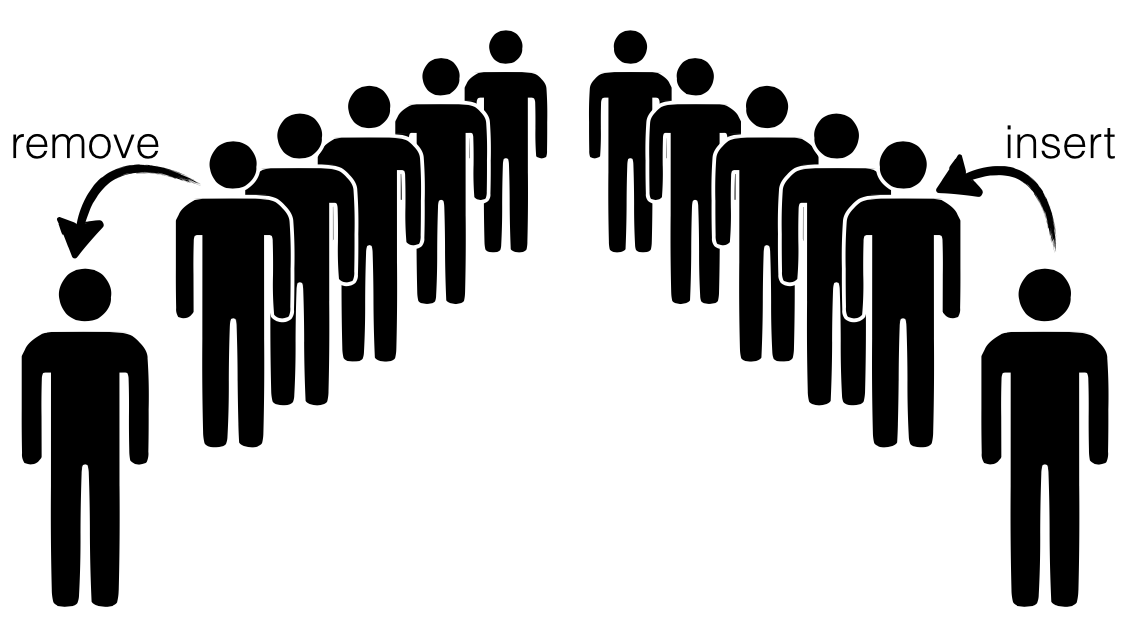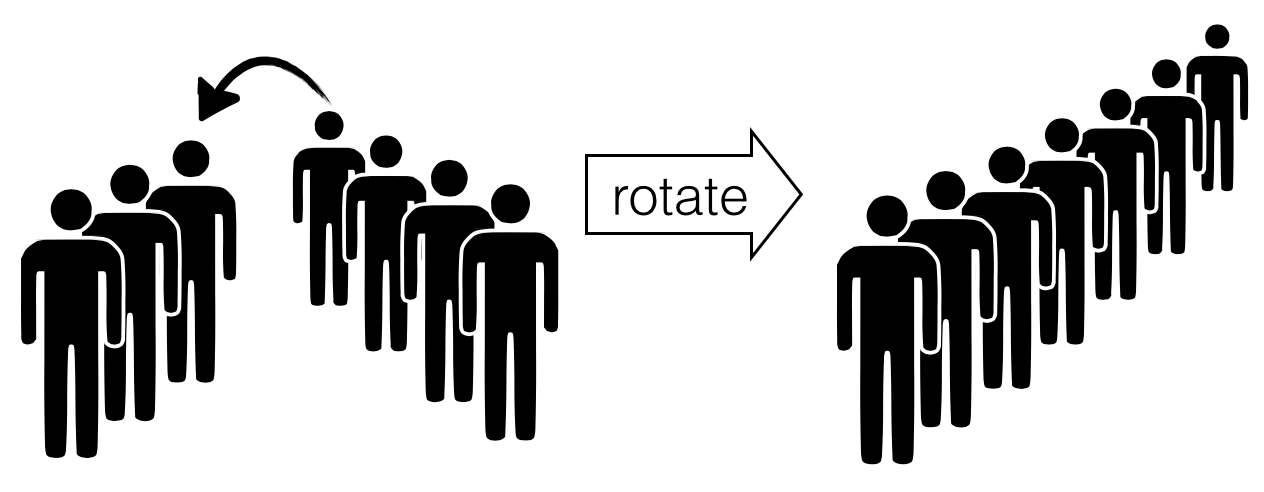Case Study: Okasaki’s Lazy Queues
Lets start with a case study that is simple enough to explain without pages of code, yet complex enough to show off whats cool about dependency: Chris Okasaki’s beautiful Lazy Queues. This structure leans heavily on an invariant to provide fast insertion and deletion. Let’s see how to enforce that invariant with LiquidHaskell.
Queues
A queue
is a structure into which we can insert and
remove data such that the order in which the data is
removed is the same as the order in which it was inserted.

To efficiently implement a queue we need to have rapid
access to both the front as well as the back because we
remove elements from former and insert
elements into the latter. This is quite straightforward with explicit
pointers and mutation – one uses an old school linked list and maintains
pointers to the head and the tail. But can we implement the structure
efficiently without having stoop so low?
Chris Okasaki came up with a very cunning way to
implement queues using a pair of lists – let’s call them
front and back which represent the
corresponding parts of the Queue.
- To
insertelements, we just cons them onto thebacklist, - To
removeelements, we just un-cons them from thefrontlist.

The catch is that we need to shunt elements from the
back to the front every so often, e.g. we can transfer the elements from
the back to the front, when:
- a
removecall is triggered, and - the
frontlist is empty.

Okasaki's first insight was to note that every element
is only moved once from the back to the front; hence, the time
for insert and remove could be
O(1) when amortized over all the operations. This
is perfect, except that some set of unlucky remove
calls (which occur when the front is empty) are stuck
paying the bill. They have a rather high latency up to O(n)
where n is the total number of operations.
Okasaki's second insight saves the day: he observed
that all we need to do is to enforce a simple balance
invariant:
\[\mbox{Size of front} \geq \mbox{Size of back}\]
If the lists are lazy i.e. only constructed as the head value is
demanded, then a single remove needs only a tiny
O(log n) in the worst case, and so no single
remove is stuck paying the bill.
Lets implement Queues and ensure the crucial
invariant(s) with LiquidHaskell. What we need are the following
ingredients:
A type for
Lists, and a way to track theirsize,A type for
Queues which encodes the balance invariantA way to implement the
insert,removeandtransferoperations.
Sized Lists
The first part is super easy. Let’s define a type:
We have a special field that saves the size because
otherwise, we have a linear time computation that wrecks Okasaki’s
careful analysis. (Actually, he presents a variant which does
not require saving the size as well, but that’s for another
day.)
How can we be sure that size is indeed the real
size of elems? Let’s write a function to
measure the real size:
Now, we can simply specify a refined type for
SList that ensures that the real size is saved in
the size field:
As a sanity check, consider this:
Lets define an alias for lists of a given size
N:
Finally, we can define a basic API for SList.
To Construct lists, we use nil and
cons:
Exercise: (Destructing Lists): We can destruct lists by
writing a hd and tl function as shown below.
Fix the specification or implementation such that the definitions
typecheck.
Hint: When you are done, okHd should be
verified, but badHd should be rejected.
Queue Type
It is quite straightforward to define the Queue type, as
a pair of lists, front and back, such that the
latter is always smaller than the former:
The alias SListLE a L corresponds to lists
with at most N elements:
As a quick check, notice that we cannot represent illegal Queues:
Queue Operations
Almost there! Now all that remains is to define the
Queue API. The code below is more or less identical to
Okasaki’s (I prefer front and back to his
left and right.)
The Empty Queue is simply one where both
front and back are both empty:
To Remove an element we pop it off the
front by using hd and tl. Notice
that the remove is only called on non-empty
Queues, which together with the key balance invariant,
ensures that the calls to hd and tl are
safe.
Exercise: (Whither pattern matching?): Can you explain
why we (or Okasaki) didn’t use pattern matching here, and have instead
opted for the explicit hd and tl?
Exercise: (Queue Sizes): If you did the List
Destructing exercise above, then you will notice that the code for
remove has a type error: namely, the calls to
hd and tl may fail if the f list
is empty.
- Write a measure to describe the queue size,
- Use it to complete the definition of
QueueNbelow, and - Use it to give
removea type that verifies the safety of the calls made tohdandtl.
Hint: When you are done, okRemove
should be accepted, badRemove should be rejected, and
emp should have the type shown below:
To Insert an element we just cons it to
the back list, and call the smart constructor
makeq to ensure that the balance invariant holds:
Exercise: (Insert): Write down a type for
insert such that replicate and
okReplicate are accepted by LiquidHaskell, but
badReplicate is rejected.
To Ensure the Invariant we use the smart constructor
makeq, which is where the heavy lifting happens. The
constructor takes two lists, the front f and back
b and if they are balanced, directly returns the
Queue, and otherwise transfers the elements from
b over using the rotate function rot described
next.
Exercise: (Rotate): The Rotate function
rot is only called when the back is one larger
than the front (we never let things drift beyond that). It
is arranged so that it the hd is built up fast, before the
entire computation finishes; which, combined with laziness provides the
efficient worst-case guarantee. Write down a type for rot
so that it typechecks and verifies the type for makeq.
Hint: You may have to modify a precondition in
makeq to capture the relationship between f
and b.
Exercise: (Transfer): Write down a signature for
take which extracts n elements from its input
q and puts them into a new output Queue. When you are done,
okTake should be accepted, but badTake should
be rejected.
Recap
Well there you have it; Okasaki’s beautiful lazy Queue, with the invariants easily expressed and checked with LiquidHaskell. This example is particularly interesting because
- The refinements express invariants that are critical for efficiency,
- The code introspects on the
sizeto guarantee the invariants, and - The code is quite simple and we hope, easy to follow!